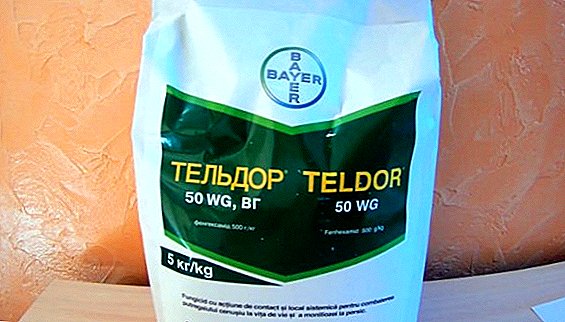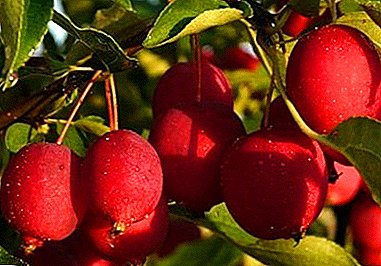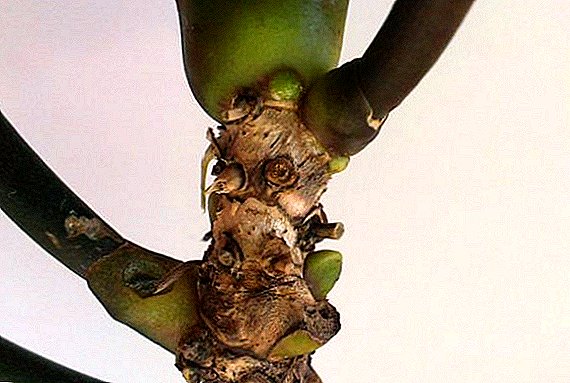 Diseases of roses and the appearance of insects on plants significantly affect the overall decorative properties of flowers, and in some cases can lead to the complete death of the plant.
Diseases of roses and the appearance of insects on plants significantly affect the overall decorative properties of flowers, and in some cases can lead to the complete death of the plant.
Therefore, it is important to know about the possible ways to protect roses from pests.
How to deal with caterpillars
Caterpillars often attack rose bushes growing in the shade. They descend on them from deciduous trees (usually in early spring) and move to the buds, penetrating inside the flower.
It is easier for the caterpillars to get the petals from the bud, eating which they make the flowers inferior. Where one caterpillar appears, soon a whole hundred pests of roses are formed, which are encountered everywhere in the country.
 It is rather difficult to fight with caterpillars, because you have to constantly collect them manually. However, this method will not be able to lead to success, because new individuals will quickly take the place of the collected ones. So what are the alternative ways to combat these pests?
It is rather difficult to fight with caterpillars, because you have to constantly collect them manually. However, this method will not be able to lead to success, because new individuals will quickly take the place of the collected ones. So what are the alternative ways to combat these pests?
If you do not turn to the help of all sorts of chemicals, which are present in large enough numbers in modern markets, it can also help in the destruction of caterpillars. ordinary mustard, although such treatment will harm not only them, but also the rose bush itself.
Did you know? Rose bushes needto spraydiluted powderin the proportion of 100 g of mustard to 10 liters of water.Mustard must be filled with warm water, which will help the solution to be better absorbed. Treated bushes are allowed to settle for two to three hours, it is even better to leave the mixture acting for a day.
You can simply sprinkle mustard around a bush - this should scare away the caterpillars that climb onto the stalks from the ground.
Methods of dealing with green aphids
 Insects on roses suck the juice from the young shoots and leaves of the plant, because of what it is deformed and dries. Also, they do not disdain and buds.
Insects on roses suck the juice from the young shoots and leaves of the plant, because of what it is deformed and dries. Also, they do not disdain and buds.
Green aphid - quite large type of pests, especially in comparison with the others. These insects have a brilliant green (in some cases brown) and long black antennae.
In the springtime, from the overwintered eggs, larvae appear, which eventually turn into wingless females. The next generations are already different winged individuals, able to fly over to the neighboring bushes and form new colonies there.
Did you know? More than ten generations of green aphids can develop over a year.
The number of this type of rose pests in the open field usually increases in June, after which they do their "dirty work" until the end of summer. In most cases, aphid settles at the ends of young shoots and in buds, but on the leaves it is not too much. Damaged buds can no longer open, and the shoots of the plants are bent.
It is necessary to start treating bushes from these pests with the appearance of the first larvae, repeating the course of treatment as needed: 2-3 weeks before the aphids completely disappear.
For these purposes, such means as Confidor, Iskra-M, Spark Double Effect, Bison, and Tanrek are often used. The advantage of these funds is their high level of efficiency (even in hot weather), the systemic mechanism of action and the rapid penetration of plant tissue. Drugs are not washed away by rain.
You can remove the green rosette aphids and mechanically, shortening damaged shoots or wiping pests with a damp cloth. Small aphid colonies are eliminated. using soap solution (grated bar of ordinary soap diluted in 10 liters of boiling water). As soon as the solution is completely cooled, it is immediately applied to the damaged bush.
Sawfly and leaf cutter
 Sawfly - hymenoptera is a small insect that can completely eat the leaves of the plant, making them transparent in some places.
Sawfly - hymenoptera is a small insect that can completely eat the leaves of the plant, making them transparent in some places.
It also gnaws the stem from the inside, which is why it remains unnoticed until you break the darkened and weakened part of the flower..
In the fight against this pest, the removal of damaged leaves and their treatment with special insecticides, as well as the spraying of the ground under a rose bush, helps well.
Important! Pest larvae may persist in the ground until next year, Therefore, it is very important to treat the ground with special means.
 Bee leaf cutter - an insect that gnaws around the edges of the leaves of roses small semicircles.
Bee leaf cutter - an insect that gnaws around the edges of the leaves of roses small semicircles.
These actions do not cause any special harm, but the distribution of nutrients through the bushes deteriorates, the general appearance of flowers deteriorates.
As a preventive measure, you can weed out thistles, thistles and other hard-to-flow weeds in the garden, in the stalks of which the leaf cutters arrange their home. Get rid of insects will help you soap solution. In addition, it is possible to protect your roses from the impact of the leaf cutter by throwing a protective net over the bushes.
Did you know? Pathogenic microflora of roses has up to 270 species.
Types of beetles on roses, and how to eliminate them
 The most dangerous species of beetles, which are often found on rose bushes, are weevil and bronzovka.
The most dangerous species of beetles, which are often found on rose bushes, are weevil and bronzovka.
Weevil (leaf beetle) - This is a fairly large beetle (up to 1 cm), which nibbles the edges of the leaves of roses. He has a black and gray color and is not able to fly.
The most active lifestyle leads at night, and during the day it hides under clumps of soil. Thanks to this mode, you can even ignore these beetles, detecting only damaged leaves of flowers.
Not only adults of the weevil are dangerous for roses, but also its larvae, which are distinguished by their quite impressive size and light beige color. They live only in the ground and feed on plant roots.
If a large number of such pests start on your plot, the roses may die, because of the severe damage to the leaves, their useful area is reduced, and the plant begins to wither.
Important! In most cases, see these beetles can be on that rose flowerthat grows in the shade of a tree or in thick plantings, where it is deprived of normal air circulation. Besides, beetle will be there are roses on plants, weakened by time and poor agricultural engineering.
 To cope with these pests by spraying rose bushes at sunset, choosing one of the most popular insecticides today. You can also try to collect the appeared beetles manually, but for this you need a flashlight (they come out only at night).
To cope with these pests by spraying rose bushes at sunset, choosing one of the most popular insecticides today. You can also try to collect the appeared beetles manually, but for this you need a flashlight (they come out only at night).
The latter option is more laborious and will require good skill from you, but if you don’t want to choose, the better to spray roses from pests (it doesn’t matter in spring or autumn), then this will be a good temporary solution.
Thrips on roses
 In hot and dry weather you can see on the back of the leaves of roses is a greyish brown patina that gives off a silvery shade. This means that your plants started thrips. The leaves damaged by them quickly turn brown and fall off, and the blooming buds deform and become covered with spots.
In hot and dry weather you can see on the back of the leaves of roses is a greyish brown patina that gives off a silvery shade. This means that your plants started thrips. The leaves damaged by them quickly turn brown and fall off, and the blooming buds deform and become covered with spots.
Moreover, the sticky black secretions that these pests leave behind are a great environment for the development of black fungi. When dealing with them, the damaged bush is treated with insecticides, which are absolutely harmless for beneficial insects.
Walnut and scoop
Nutcracker - another insect dangerous to roses, reaching a length of 2-3 mm. It has a black body, squeezed from two sides, and a stalked abdomen. If you look inside one of the blisters (it is their nut-pots that form), then you will surely find an insect larva there.
 Such blooms can be placed on the shoots, flowers and leaves, often reaching 5 cm. In some cases, this leads to the death of the plant.
Such blooms can be placed on the shoots, flowers and leaves, often reaching 5 cm. In some cases, this leads to the death of the plant.
You can save your roses from such a misfortune with the help of the same pesticides that are used in the fight against other pests, twice sprinkling the plant.
Good results are obtained with the use of the drug "Lightning" (2 ml of the product is diluted with 10 liters of water).
Important! In parallel with chemical processing, it is better to carry on and mechanical struggle, that is, to cut and burn the growths that appear.Scoops - pest that lives in the ground and feeds only at night. Therefore, most often you can see only traces of its activity.
If there is a lot of damage, then it is better to immediately use pest preparations (the same insecticides will do as against aphids). Depending on the strength of the damage, the bud may give a deformed flower, which means that it is better not to leave it on the plant.
Spider mites on leaves
Among insects that are pests of roses, should be highlighted spider mite. Of all existing insect pests, the spider mite is the most common and becomes the cause of weakening of plants. Affected rose bushes quickly lose their leaves and are more vulnerable to various diseases.
 This pest is quite a small insect (no more than 2 mm), which is why it is very difficult to detect. Spider mite forms whole colonies, the number of which may be more than 100 individuals.
This pest is quite a small insect (no more than 2 mm), which is why it is very difficult to detect. Spider mite forms whole colonies, the number of which may be more than 100 individuals.
With a small amount of spider mites, you should not worry, but you should always take into account the fact that this pest multiplies very quickly, which leads to disastrous consequences for plants.
Feeding on leafy juice, especially when the plant is at the stage of active growth, the insect helps to weaken the rose, and it has to compensate for the losses due to the root system. Young seedlings are especially affected by exhaustion.
Important! It is possible to detect the pest on the inner side of the leaves of the rose, where a rather thick web is formed, under which small insects run.If you want to get rid of the spider mite for a long time, then you need to fight it at all stages of its life cycle.
All summer you need to process the plants with special chemical compounds, and in the fall, when the cold comes and the insect moves to the fallen leaves, you need to carry out a thorough cleaning and burn the fallen leaves. Thus, you will not only rid yourself of pests, but also destroy the spores of many fungal diseases.
Rose cicada
 Rosa Cicada - one of the smallest insect pests (body length of an adult individual reaches only 3-4 mm). It has two pairs of wings and long rear jumping legs. The insect infects the leaves of plants, eating out the flesh of them and laying the larvae in the stems of roses. The leaves of the flowers quickly turn yellow and fall off.
Rosa Cicada - one of the smallest insect pests (body length of an adult individual reaches only 3-4 mm). It has two pairs of wings and long rear jumping legs. The insect infects the leaves of plants, eating out the flesh of them and laying the larvae in the stems of roses. The leaves of the flowers quickly turn yellow and fall off.
Choosing, than spraying a rose from this pest, it is better to give preference to standard insecticides (for example, "Aktar"), although it will be most correct to carry out timely preventive measures during the autumn earthworks.
What contributes to the appearance of pests on the rose
In addition to the attacks of harmful insects, roses often suffer from a lack of micronutrients in the soil. This is an extremely negative impact on the development and flowering of plants. Therefore, in order for rose bushes to grow healthy and to delight you, they must be located in a sunny area, where there will be constant air circulation.
Important! Regular mineral and liquid dressings significantly improve the condition of the soil and have a positive effect on the development of roses. An excess of nutrients in the soil is also harmful.
When choosing a site for planting, it is necessary to avoid damp and shaded places (for example, under large trees), although an equally important factor is the quality of processing of the selected site.
Rose disease outbreaks they appear on wet summer days, as a humid and warm environment is excellent conditions for the development of all kinds of infections. It is necessary to understand that such conditions are created even with a strong thickening of the bushes, when the leaves cannot dry for a long time after rain or watering. In such cases, thinning is necessary in time.
The fight against diseases must begin at their first manifestation, because if you miss this moment, the weakened plant will quickly cease to bloom and may simply not survive the winter.
Ie, having seen worms, caterpillars, beetles or any other insects on your roses, you now know what to do: the main thing is to process the damaged shrub in time and prevent the problem from spreading.












